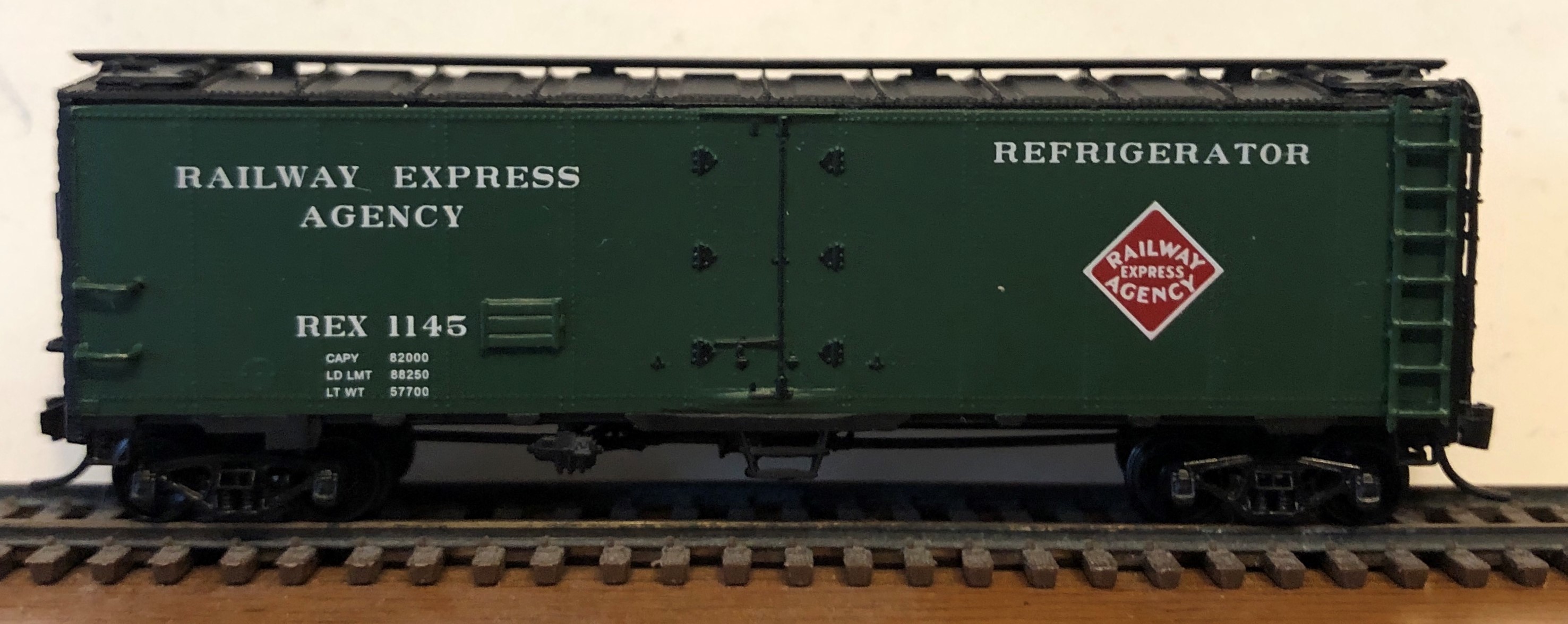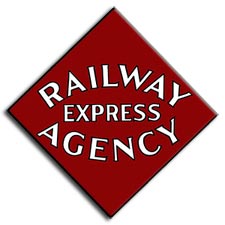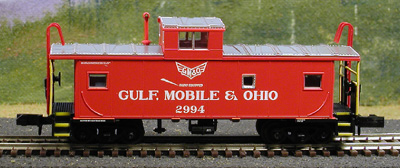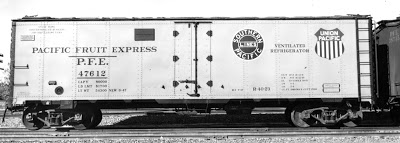Model Information: This model was first produced in the 1990s by InterMountain and was originally only available as a kit. More recent releases are only available as RTR (Ready-to-Run) models. It is a very nicely detailed and even after 20 years in production, it remains one of the best N Scale reefer models available. This is likely due to the fact that it was originally available only as a kit that it has so many fine detail parts such as the intricate handrails. My guess is that InterMountain simply didn't worry about the cost of the assembly as they were shipping them assembled. Hence they have far more detail than similar models from Atlas or Micro-Trains.
In addition the the numerous paint schemes, InterMountain has produced a large number of special runs, with some particularly attractive examples produced for YesterYear. Over the years, the couplers supplied with this model have varied a lot. The original release featured dummy knuckle couplers, but I have also seen examples with Micro-Trains couplers, Accumate couplers and Micro-Trains knockoffs.
In addition the the numerous paint schemes, InterMountain has produced a large number of special runs, with some particularly attractive examples produced for YesterYear. Over the years, the couplers supplied with this model have varied a lot. The original release featured dummy knuckle couplers, but I have also seen examples with Micro-Trains couplers, Accumate couplers and Micro-Trains knockoffs.
Prototype History: PFE built the Class R-40-23 steel ice-cooled refrigerator car in 1947. This was the largest class of steel cars they built. In this version, the placard board was moved to the left of the car door and a little higher, and the smaller board seen on Class R-40-20 was omitted. And once again, the route card board was applied at the left bolster.
These cars feature Murphy steel roofs, W-corner 3/3 Improved Dreadnaught ends and 4'-0" doors. A group of 1000 cars was converted for Temco service and renumbered 20002-21001 in 1960-61. Another group of 15 cars was rebuilt with 6' plug doors for Polarstream Liquid Nitrogen cooling and renumbered 1001-1015 in 1965. Another group of 239 cars was renumbered into the 36001-36500 series for TIV service in 1965-66. The Temco equipped cars had it removed in 1966 and were renumbered to 35002-36000. The cars 1001-1015 were renumbered 36501-36515 for TIV service in 1968.
These cars feature Murphy steel roofs, W-corner 3/3 Improved Dreadnaught ends and 4'-0" doors. A group of 1000 cars was converted for Temco service and renumbered 20002-21001 in 1960-61. Another group of 15 cars was rebuilt with 6' plug doors for Polarstream Liquid Nitrogen cooling and renumbered 1001-1015 in 1965. Another group of 239 cars was renumbered into the 36001-36500 series for TIV service in 1965-66. The Temco equipped cars had it removed in 1966 and were renumbered to 35002-36000. The cars 1001-1015 were renumbered 36501-36515 for TIV service in 1968.
Road Name History: The Railway Express Agency (REA) was a national monopoly set up by the United States federal government in 1917. Rail express services provided small package and parcel transportation using the extant railroad infrastructure much as UPS functions today using the road system. The United States government was concerned about the rapid, safe movement of parcels, money, and goods during World War I and REA was its solution to this problem. REA ceased operations in 1975, when its business model ceased to be viable.
The first parcel express agency in the United States is generally considered to have been started by William Frederick Harnden (1812-1845), who in 1839 began regular trips between New York City and Boston, Massachusetts as a courier transporting small parcels, currency and other valuables. William G. Fargo, a New York Central freight clerk at Auburn, N.Y., and Henry Wells, a leather worker at Batavia, N.Y., organized Wells Fargo & Co. in 1853. Other parcel express pioneers include Henry B. Plant, who formed Southern Express Company, Alvin Adams who founded Adams Express Company, and John Warren Butterfield. Express delivery in the early 19th century was virtually all done via horse, either via stagecoach or by riders. Ad for a railroad, showing American Railway Express service along the line. 1922
The express business flourished in the latter half of the 19th century, and by 1900 there were four principal parcel express companies, all of which included the rapidly advancing railways as one of their means of transport: Adams Express Company, Southern Express Company, American Express Company, and Wells Fargo. In 1913 the U.S. Post Office introduced its Parcel Post service, which offered major competition for the express companies. Despite this, private railway express business increased steadily through the end of World War I.
During World War I, the United States Railroad Administration (USRA) took over the nation's railroads. Under the USRA, the four major and three minor express companies were consolidated as American Railway Express, Inc., save the portion of Southern Express that operated over the Southern Railway and the Mobile & Ohio. Railway Express Agency office, San Augustine, Texas, 1939 REA electric truck circa 1920.
In March 1929, the assets and operations of American Railway Express Inc. were transferred to Railway Express Agency (REA). REA was owned by 86 railroads in proportion to the express traffic on their lines - no one railroad or group of railroads had control of the agency. In response to customer demand, REA added a Chicago, Illinois-based refrigerator car line. In 1927, REA began an Air Express Division. In 1938, the remainder of Southern Express also joined the consolidated REA.
The first parcel express agency in the United States is generally considered to have been started by William Frederick Harnden (1812-1845), who in 1839 began regular trips between New York City and Boston, Massachusetts as a courier transporting small parcels, currency and other valuables. William G. Fargo, a New York Central freight clerk at Auburn, N.Y., and Henry Wells, a leather worker at Batavia, N.Y., organized Wells Fargo & Co. in 1853. Other parcel express pioneers include Henry B. Plant, who formed Southern Express Company, Alvin Adams who founded Adams Express Company, and John Warren Butterfield. Express delivery in the early 19th century was virtually all done via horse, either via stagecoach or by riders. Ad for a railroad, showing American Railway Express service along the line. 1922
The express business flourished in the latter half of the 19th century, and by 1900 there were four principal parcel express companies, all of which included the rapidly advancing railways as one of their means of transport: Adams Express Company, Southern Express Company, American Express Company, and Wells Fargo. In 1913 the U.S. Post Office introduced its Parcel Post service, which offered major competition for the express companies. Despite this, private railway express business increased steadily through the end of World War I.
During World War I, the United States Railroad Administration (USRA) took over the nation's railroads. Under the USRA, the four major and three minor express companies were consolidated as American Railway Express, Inc., save the portion of Southern Express that operated over the Southern Railway and the Mobile & Ohio. Railway Express Agency office, San Augustine, Texas, 1939 REA electric truck circa 1920.
In March 1929, the assets and operations of American Railway Express Inc. were transferred to Railway Express Agency (REA). REA was owned by 86 railroads in proportion to the express traffic on their lines - no one railroad or group of railroads had control of the agency. In response to customer demand, REA added a Chicago, Illinois-based refrigerator car line. In 1927, REA began an Air Express Division. In 1938, the remainder of Southern Express also joined the consolidated REA.
Brand/Importer Information: InterMountain was founded in 1985 by Fred Brummet. They got started in the model railroad business by producing O-Scale model kits. They got started in the N Scale business almost a decade later when in 1994 they introduced the 40-23 reefer car in kit form. Later, in 1998, they started producing RTR (Ready-to-Run) models. By the early 2000s, InterMountain phased out kit production in favor of the RTR models.
The InterMountain Railway company is located at 1224 Boston Ave in Longmont, CO. They are a manufacturer of HO, N and Z scale model trains. They have produced kits as well as RTR (Ready-To-Run) models. Their N Scale products include locomotives as well as rolling stock. Their rolling stock lineup includes Boxcars, Hoppers, Tank Cars, Reefers, Gondolas, Stock Cars and Flatcars.
Their locomotive releases have primarily been diesel units, with the one major exception being their series of AC-12 Cab Forward steam locos. Their diesel lineup includes F3's, F7's, F9's, SD40's, SD45's and FT units. They are known for quality and detail. They also release their rolling stock in larger varieties of road numbers than most of the other manufacturers.
The InterMountain Railway company is located at 1224 Boston Ave in Longmont, CO. They are a manufacturer of HO, N and Z scale model trains. They have produced kits as well as RTR (Ready-To-Run) models. Their N Scale products include locomotives as well as rolling stock. Their rolling stock lineup includes Boxcars, Hoppers, Tank Cars, Reefers, Gondolas, Stock Cars and Flatcars.
Their locomotive releases have primarily been diesel units, with the one major exception being their series of AC-12 Cab Forward steam locos. Their diesel lineup includes F3's, F7's, F9's, SD40's, SD45's and FT units. They are known for quality and detail. They also release their rolling stock in larger varieties of road numbers than most of the other manufacturers.
Item created by: gdm on 2016-11-14 09:36:57. Last edited by dennis.kamper on 2022-01-28 05:50:54
If you see errors or missing data in this entry, please feel free to log in and edit it. Anyone with a Gmail account can log in instantly.
If you see errors or missing data in this entry, please feel free to log in and edit it. Anyone with a Gmail account can log in instantly.











